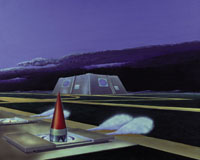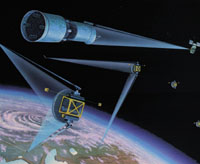
|
The Soviet
Challenge In Space: Illustrating The Threat
|
Defensive Weapons
Beginning in the 1960s,
the Soviet Union conducted a substantial research program to develop
a defense against ballistic missiles. The Soviets built, and Russia
continues to maintain, the world's only operational anti-ballistic
missile system. Additional programs focused on the development of
other ground- and space-based weapons using laser, particle beam,
and kinetic energy technology.
|
| |
|
 |
Pushkino ABM Site
The Soviet Union built
the world's only operational anti-ballistic missile (ABM) system
around Moscow in the 1970s. Beginning in 1980, they improved and
expanded this system. Two of these improvements are shown in this
1983 illustration: the silo-based, nuclear-tipped Gazelle interceptor
missile and a new large radar intended to control ABM engagements.
31k JPEG
Image courtesy DIA
|
| |
|
 |
Space Laser
Soviet research into
ground- and space-based laser weapons systems began in the 1960s.
The Soviets actually built several ground-based lasers in the 1980s,
which reportedly could destroy or interfere with satellites and
aircraft. The space-based laser system envisioned in this 1987 work
was designed to destroy or incapacitate satellites and intercontinental
ballistic missiles, but it was never built.
39k JPEG
Image courtesy DIA
|
| |
|
|

|
Particle Beam Weapon
The Soviets first explored
the use of space-based particle beam weapons in the late 1960s.
As portrayed in this 1987 illustration, the weapon would have targeted
satellite or intercontinental ballistic missiles with high-velocity
particle beams. The Soviet Union also studied other space-based
directed-energy weapons, including some using laser and kinetic
energy technology. None of these types of weapons was ever deployed.
34k JPEG
Image courtesy DIA
|
|